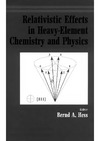Heavy atoms and their compounds are important in many areas of modern technology. Their versatility in the reactions they undergo is the reason that they can be found in most homogeneous and heterogeneous catalysts. Their magnetism is the decisive property that qualifies them as materials for modern storage devices. The phenomena observed in compounds of heavy atoms such as phosphorescence, magnetism or the tendency for high valency in chemical reactions can to a large extent be traced back to relativistic effects in their electronic structure. Thus, in many aspects relativistic effects dominate the physics and chemistry of heavy atoms and their compounds.
Chemists are usually aware of these phenomena, however, the theory behind them is not part of the standard chemistry curriculum and thus not widely known among experimentalists. Whilst the relativistic quantum theory of electronic structure is well established in physics, applications of the theory to chemical systems and materials have been feasible only in the last decade and their practical applications in connection with chemical experiment is somewhat out of sight of modern theoretical physics.
Relativistic Effects in Heavy Element Chemistry and Physics intends to bridge the gap between chemistry and physics on the one hand and between theory and experiment on the other.
Topics covered include:
A broad range from quantum electrodynamics to the phenomenology of the compounds of heavy and superheavy elements A state-of-the-art survey of the most important theoretical developments and applications in the field of relativistic effects in heavy-element chemistry and physics in the last decade Special emphasis on the work of researchers in Europe and Germany in the framework of research programmes of the European Science Foundation and the German Science Foundation
 |
|
О проекте
|
|
О проекте


